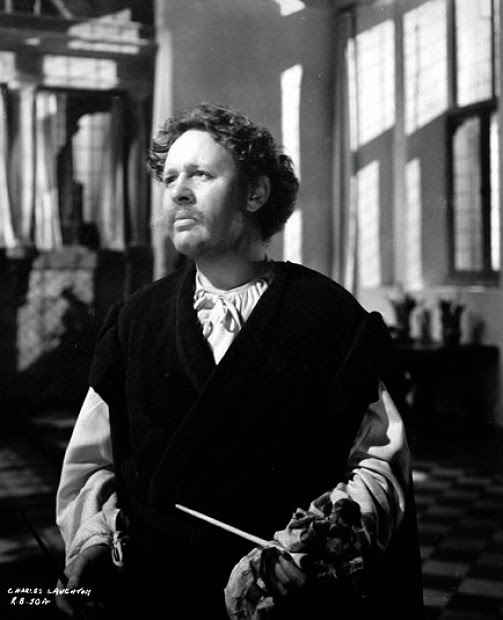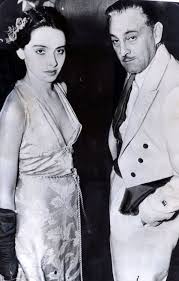The folks at New York City’s Film Forum have just started
a three-week, 35-film tribute to Charles Laughton. Obviously, they love the Siren and want her to be happy. That’s her working theory, anyway. April of this year will mark a full decade since the Siren began spinning in her corner of the Web. And Laughton was one of the first people she chose to write about.
What makes you adopt an actor? How do you decide that here’s a performer you will seek out, regardless of the vehicle? The Siren is always drawn to an actor who takes a 20-foot-high screen and gives you a focused, intelligent performance that fills out every square inch. That’s Laughton. His kind of acting is, sadly, not very fashionable anymore. Even Simon Callow,
who wrote a fantastic biography that focuses almost entirely on the acting, admits Laughton’s fame these days is tied to
The Night of the Hunter, his one-off directorial masterpiece. Laughton’s acting is “virtually unknown by anyone under 40,” Callow wrote recently.
Or, in some cases, worse than forgotten. “Laughton's mannered performances are liable to elicit laughter today,” sniffs one writer reviewing Callow’s book. This prompts the Siren to a rare display of temper. Mannered? What could be more mannered than some contemporary actors who wait for the camera to discover each tiny effect as they overact their underacting? (That is, if indeed they are actors; of late the Siren has endured too many nonprofessionals cast by wannabe Bressons.) You can keep that kind of pallid realism, where the goal is to be the closest thing to real life. Sure, it’s close. And real life is being on hold with the airline, or flossing your teeth, or staring into the middle distance while trying to recall whether you took your vitamins. The Siren doesn’t require tedium to be all that accurate.
Give her someone like Charles Laughton, who aimed big, even if from time to time he failed big. Give her the existential truth he dredges up, say, at the climax of
Mutiny on the Bounty. God no, it’s not “realistic,” but for all time and no matter who else plays him, there’s
Captain Bligh, standing in a rowboat, bellowing: “Casting me adrift 3,500 miles from a port of call! You're sending me to my doom, eh? Well, you're wrong, Christian! I'll take this boat as she floats, to England, if I must! I'll live to see you —
all of you— hanging from the highest yardarm in the British Fleet!”
Now if you were an actor in class, assigned the unenviable task of recreating that speech, your action might be something like “placing a curse.” Captain Bligh is, in this MGM production of 80 years ago, a villain, a man who cares more about breadfruit than the human beings under his command. But as an actor, Laughton knows obsessiveness can bring about disaster, or it can keep a person alive. Bligh is transferring all his passion to the task of survival, so he can have his revenge. And Laughton points his hand as though he could reach up and tie the rope around Clark Gable’s neck himself. He’s not merely shouting, he layers hatred and determination under every syllable, pronouncing “ChrisCHUHN” so that the very name carries the wrath of the Almighty.
![]()
In other words, this is an actor who performed with ferocious totality. That’s what it takes to etch a character in the public mind. When people joke about Henry VIII picking up half a chicken and tearing the meat off with his teeth, they’re not remembering Holbein. They’re evoking Charles Laughton. Lon Chaney created a good Quasimodo, in the 1923
The Hunchback of Notre Dame, one that was quite close to the 19th-century illustrations of Victor Hugo’s book. But when Disney cleaned up the tale of the hunchback and the gypsy, to puzzling effect, they were, quite openly, doing a prettified version of Laughton. That’s because it was his Quasimodo, falling in love with Maureen O’Hara’s Esmeralda in the course of a single shot, who broke hearts. These images are there because Laughton’s performances put them there.
He achieved his effects through subtle methods as well as grand ones. For
Rembrandt, a biopic directed by Alexander Korda, Laughton immersed himself in the artist’s work for weeks on end. It’s a somber movie, focused on Rembrandt’s tragic private life, and also on how his paintings gradually lost favor, even as Rembrandt was at the peak of his genius. Aided by the sensitive lighting of cinematographer Georges Perinal, Laughton approaches a canvas as though acceding to its demands. “Every man has a destined path,” says Laughton’s Rembrandt. “It leads him into the wilderness but he must follow it with head high and a smile on his lips.” It is no surprise to learn that Mike Leigh, in interviews, cites
Rembrandt as a key influence on
Mr. Turner.
Charles Laughton was born in 1899, the son of hoteliers. He worked until his early 20s in his parents’ hotel, starting at the lowest rung of the trade at the insistence of his formidable mother. His upbringing was prosperous, and he went to private schools such as Stonyhurst. He didn’t begin his acting career until his early 20s, after overcoming the strenuous disapproval of his family. But Laughton, somehow, never identified much with privilege. Off-screen he pulled away from “toffs” all his life. When he played a bank clerk, a servant, a schoolteacher, he brought a rare and deep understanding of what it means to work hard for meager pay and nonexistent rank. And Laughton also reveled in showing what’s behind the petty exercise of power, say by a Victorian toff with his invalid poet-daughter in
The Barretts of Wimpole Street, or a bootmaker of a similar era in
Hobson's Choice, or, in
The Big Clock, a CEO who finds a single light burning in a broom closet at his corporate headquarters.
He served in World War I as a private, saw time in the trenches, and was exposed to mustard gas in the last vicious weeks before peace. It damaged his throat and left him with painful, recurring hives for the rest of his life. The emotional effects of his service are harder to discover, because Laughton preferred not to speak of them. Still, Callow points to a possible connection between the ignoble terror of certain moments in
This Land Is Mine, and the memories of war, and that feels right. In Jean Renoir’s superb movie about the occupation of a small (obviously French) town, there is a scene where Laughton’s Alfred Lory, a schoolteacher, looks out the window of his cell and sees his headmaster being marched to a firing squad. Lory was supposed to call to him: “Professor Sorel! Professor Sorel!” On the first take, Laughton gripped the bars on the window so hard they broke off.
Laughton had a stormy, complicated marriage to Elsa Lanchester that lasted from 1927 until his death in 1962. He was gay, and Laughton’s era was not, of course, hospitable to same-sex relationships, although the older he got, the more affairs he had, and the more frequently he would confide in people. (As he took a drive with Robert Mitchum during the filming of
Night of the Hunter, Laughton confessed to his star that “there is a strong streak of homosexuality in me.” Mitchum’s priceless response: “No shit! Stop the car!”) Most good actors can suggest sexual undercurrents driving their characters, but Laughton treated desire, even in murderers like those in
The Big Clock and
Jamaica Inn, as an outgrowth of the mind, not merely a physical urge.
Seeing a big portion of Laughton’s work at Film Forum should dispel the notion that he was always massively overweight; he’s in pretty good shape in
Mutiny on the Bounty, for example. He was an aesthete who prized the best and highest in music, in literature and in art. (One bond he had with Jean Renoir: Laughton had bought Renoir pere’s
The Judgment of Paris for $35,000 in the 1930s.) But this man who loved beauty saw none in himself, no matter if Marilyn Monroe said he was “the sexiest thing she’d ever seen,” no matter if Marlene Dietrich told him before they started
Witness for the Prosecution that she’d always yearned to play opposite him. “I look like a departing pachyderm,” he once said. The Siren never reads that joke without a wince. His looks did mean he would never be a leading man, but that is our good fortune; how many Hollywood idols could have created just one of Laughton’s monsters?
The Film Forum series shows that Laughton was also exceptional at more ordinary specimens of humanity. In
The Suspect, directed by Robert Siodmak, Laughton is cast as a version of
Dr. Crippen, a rare sympathetic figure in the annals of true crime — not least because he may not have actually murdered his wife, a possibility the film toys with, but basically rejects. Philip Marshall (Laughton) is chained in marriage to a vicious shrew (Rosalind Ivan, rehearsing her character in
Scarlet Street, but doing it well); inevitably, he falls love with a gentle young woman (Ella Raines, who seemingly spent much of the 1940s cast as the foil to murderers). Made on an obviously low budget, it is still a fine movie, and Laughton and Elsa Lanchester considered Marshall to be one of his best creations. The tension comes from the question of which will win out, Marshall the murderer, or Marshall, the man who says, with infinite sadness, “I like people and I’ve never wanted to hurt them.” At a key late moment, Marshall is afraid that his secret is about to be discovered during a quiet social evening at home. As his own son fumbles around the spot that could reveal all, Marshall keeps smiling; you can watch the gradual transition, as Laughton’s smile turns into a ghastly mask of dread.
To a director, Laughton on set meant there would always be more than one temperament around, and Siodmak said later that
The Suspect forced him into an unusual approach. When Laughton one day barged in declaring that every take had been wrong, all wrong, and would have to be redone, Siodmak responded by reeling around declaiming the actor's lines himself. Laughton became convinced he’d finally encountered a director who actually was a lunatic, as opposed to merely behaving like one. And after that, claimed Siodmak, his star was as gentle as the rain.
Jean Renoir was patient and kind, as he seemed to be with everyone, and mentioned Laughton fondly in interviews. During
Spartacus, Stanley Kubrick had his hands full, what with the glory that was Rome and the grandeur that was Kirk Douglas, and let Laughton and Peter Ustinov rewrite most of their scenes together. Billy Wilder, who helped Robert Stephens to a breakdown and James Cagney to leaving the business, described making
Witness for the Prosecution as delightful. (The Siren has watched that movie over and over again — it’s Laughton’s funniest, most wholly endearing performance. His scenes with Lanchester are perfection.) Otto Preminger (rather surprising, this one) treated Laughton with the utmost courtesy during
Advise and Consent. He probably realized the actor was dying of cancer and that Senator Seb Cooley would be Laughton's last role. Laughton's physical condition caused him to play Cooley (obviously written as a portrait of Strom Thurmond) with spidery stillness. But Preminger also said Laughton asked for direction and was eager to take it.
Other times it was a different story. Even Laughton’s friends and admirers said he was hard to work with. Those directors who emerged with good memories tended to be ones who recognized that Laughton’s extreme seriousness was no act. Garson Kanin, who directed
They Knew What They Wanted (long out of sight, not Laughton’s best work, and not part of the series), claimed to have respected Laughton, at least before shooting began. Laughton told Kanin that to play an Italian-American farmer, he would immerse himself in Vivaldi, Dante and Michelangelo. In his book
Hollywood, Kanin all but calls this a sham.
But the fact is, that was absolutely Laughton’s approach, as it had been with
Rembrandt. Alfred Hitchcock could have testified to that as well. When Laughton was unable to get his walk right as the sinister squire of
Jamaica Inn, he refused to continue. He came back the next day saying he’d discovered how to do it, by listening to Carl Maria von Weber’s
Invitation to the Dance.
Hitchcock, however, responded to this sort of thing about as well as Kanin did. Hitch liked his actors to be either consummate pros, who got the job done without fuss, or malleable, tentative souls he could push around as he liked. Laughton was the worst of both worlds: a headstrong talent who needed as much time and patience as any neophyte. Laughton's malevolent judge in
The Paradine Case (poor
Paradine Case, the Siren loves you even if no one else does) was a somewhat better experience. But Hitchcock told Pia Lindstrom years later, with placid malice, “The hardest things to photograph are dogs, babies, motor boats and Charles Laughton.”
Mind you, the Siren understands Hitchcock’s point of view. To see the way Laughton struggled, and directors struggled with him, you need only look at one 70-minute documentary:
The Epic That Never Was, which Film Forum is showing on Feb. 22. Made in 1965 for the BBC, it pieces together what’s left of an effort to film Robert Graves’
I, Claudius in 1937. Laughton, who’d already been a memorably depraved Nero in
The Sign of the Cross, was obvious casting as the stammering Roman who feigns stupidity in order to stay alive, and ends up as emperor. Josef von Sternberg, who’d just ended his string of sumptuously erotic films with Marlene Dietrich, was likewise a natural to film the dissipation of the ancients.
As they say, it seemed like a good idea at the time. Instead it was a disaster that ended with Merle Oberon (cast as Messalina) wrecking her car and her producer husband Alex Korda deciding that a nice tidy insurance settlement beat the heck out of making this movie.
![]()
More than anything, Laughton was ill-matched with Von Sternberg, who wrote, “An actor is rewarded with attention out of all proportion to his services. An actor is turned on and off like a spigot, and like the spigot, is not the source of the liquid that flows through him.” Laughton admired Von Sternberg greatly, but this was not a director who was going to understand why his spigot was studying the exact way a Roman would address the gods. There are many outtakes of Laughton stopping mid-scene, or just up and leaving the set. You could say Von Sternberg lacked sympathy. “Acting is nothing remarkable,” he wrote, and meant every word. And in fairness, more often than not, when Laughton stops, it’s difficult at first to figure out why. He sounds fine. Sometimes he sounds great. Imagine you’re Von Sternberg, or, if you prefer, Hitchcock, with the crew seething and the hot breath of the studio executives steaming up the set, and all that’s between you and the film you can already watch in your head is this ACTOR and his insistence on forging things in the smithy of his soul.
“Jesus Christ, Charles, just hit your mark
and say the line.”
And then, Laughton addresses the Senate … and soars. In one scene he becomes every belittled, misjudged man who ever stood up and said, this is not who I am. At last it is possible to understand why Laughton placed such significance on the
interior. He was
acting the other takes, and they were good; in this one, he is
being, and it is art.
Those who talk only of the single film Laughton directed, and shrug off the rest, are making a grave mistake. Laughton the director could never have made the shimmering, perfect thing that is
Night of the Hunter, if it hadn’t been for Laughton the actor.
Links:
The schedule for Film Forum's Charles Laughton series
can be found here. A restored
Spartacus is screening this spring after the series concludes. Several rarities are being shown, including
Forever and a Day and
Arch of Triumph, neither of which the Siren has seen (yet). Also, though Laughton's part amounts to a glimpse, the dazzling
Piccadilly is worth your time and includes one of Anna May Wong's best roles.
The Siren has in the past written about
Ruggles of Red Gap,
The Big Clock,
Jamaica Inn and the charming Deanna Durbin vehicle
It Started With Eve. She prefers David Cairns on
The Man on the Eiffel Towerto her own post, which was written in a state of extreme irritation from the lousy DVD she watched.
























































.jpg)
































































